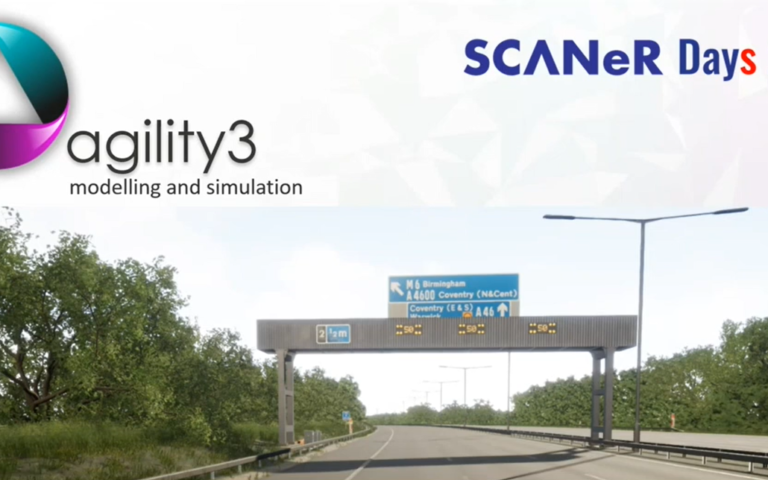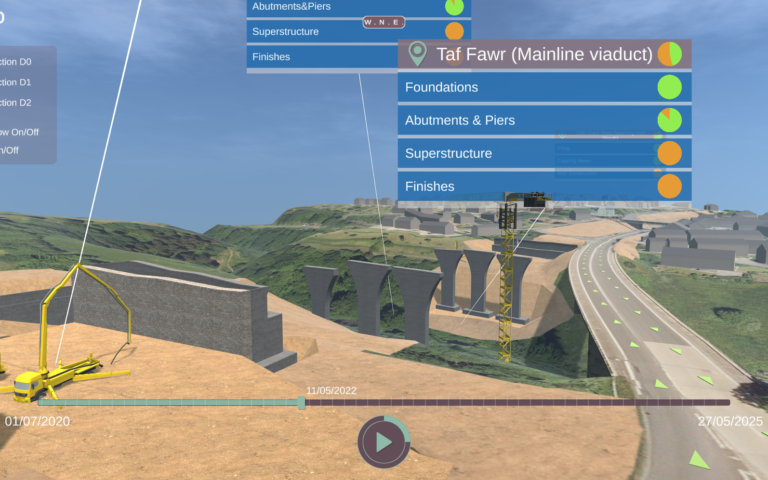For construction and architecture clients, and the authorities and agencies involved in scrutinising and approving their projects, delivering successful work on time and on budget is becoming an increasingly digital undertaking.
This isn’t just an organic evolution within the industry itself. Digital transformation is being heavily championed and funded by the UK Government, which has invested over £170 million in digital construction initiatives, via the Construction Sector Deal, in the Construction Innovation Hub, Active Building Centre, and various research and demonstration activities.
At Agility3, our experience in 3D visualisation and simulation across other industries – road, rail, defence, and industrial equipment – has put us at the forefront of many construction industry programmes, and what emerges time and again in our engagement with clients and stakeholders is that the “cleverness” or innovativeness of digital technology is no reason, of itself, to enthusiastically adopt it.
Instead, there are cultural, organisational, and psychological perspectives to be addressed in order to navigate the digital opportunity and demonstrate – all-importantly – that digital can add significant value over and above the way things “have always been done before”.
This is how we tackle those challenges to ensure digital transformation takes our clients’ business to a better – not just a different – place.
Resistance: respect it, understand it, respond to it
It is critical, first of all, not to mistake resistance to digital change in the construction industry for stubbornness or intransigence.
Yes, resistance to change is often inherent in this industry, but there is very good reason for it. In projects of great complexity, involving huge capital sums, why would a client voluntarily introduce a new risk to fix a process that, to date, whilst perhaps imperfect, does not appear broken?
At Agility3, we have found that the key to overcoming this resistance is to gain a deeper insight into clients’ day-to-day challenges and processes, and for two reasons – firstly, to identify how a digital approach can resolve or reduce the impact of existing issues, and, secondly, to ensure that the use of digital technologies does not disrupt tried and tested processes that are proven to deliver.
As Agility3 Director David Turner explains, “We do a lot of work around understanding the processes that organisations follow, how the interaction with people works, what the pain points are, and what we need to do to fit in with all that.”
There is, regrettably, something of a track record of poor digital uptake in some respects in construction – a case in point being revealed in a recent survey, showing that over 50% of construction managers “hardly ever” make use of digital BIM (Building Information Modelling) on their projects.
Any new digital process that cannot be shown to address specific needs and opportunities for improvement is likely to face the same fate.
Build it to prove it – but start small
The move from demonstrating a digital innovation’s ability to improve a process or address a pain point to actually providing a solution that delivers on that promise is critical – but it also requires organisational sensitivity and operational restraint.
Delivering an extensive, all-encompassing system often isn’t the most effective way forward for the client in organisations where digital acceptance is still tentative or partial at best.
David Turner advocates focusing instead on an approach that is initially more limited in scope, but more aligned to outputs and results that clients will immediately understand and see value in. “Start small,” he says, “do a proof of concept, show how it delivers benefit, then build on top of that.”
Often, the benefit that is felt most strongly by clients at this stage is the ability to, as Turner puts it, “get the right information to the right people, at the right time.”
After all, whilst collaboration is a much-vaunted benefit of digital transformation, a “collaborative workspace” that lacks the information to populate it is deeply ineffective.
Transform to outperform
That said, digital collaboration isn’t just about ensuring information is available and shareable.
It’s also about presenting that information in a more accessible, interpretable way, and in the construction sector there is some serious competitive advantage to be had from getting this right.
For many of Agility3’s clients, for example, competing successfully with other businesses to pitch designs for construction projects often revolves around the ability to make an extremely complex body of data readily and visually understandable to many different levels of stakeholder and decision-maker.
Indeed, David Turner emphasises that “digital collaboration methods tend to be adopted because communicating complex project ideas to decision-makers and stakeholders more successfully than the competition is often key to our clients winning tenders and new business.”
In any business, commercial drivers help to smooth the passage of new approaches, and in the high-stakes construction sector this effect is particularly keenly felt. The realisation, then, that digital transformation can be about not just delivering a better way of doing business, but ensuring there is more business to be done, is potentially a powerful route to securing its wider adoption.
Listening, learning, talking
There can be no doubt that digital transformation in construction can be a complex topic, and at Agility3 we are always keen both to learn from how other construction industry players are facing up to these challenges, and to use our expertise and experience to help those businesses achieve their digital transformation goals wherever we can.
For this reason, we have both engaged with specialists and experts from many construction disciplines in industry forums, and also conducted our own original research, to afford us greater insight into the challenges digital transformation presents, and how to overcome them.
At the same time, our customer projects to advance digital transformation in other industries (see our recent case studies on Dutch national rail network ProRail and the Birmingham Centre for Rail Research and Education (BCRRE) have given us new perspectives onto digital transformation, and demonstrated the success that such transformation – properly executed – can deliver.
In short, where there’s a pain point to be resolved, or a competitive edge to be had, digital transformation is increasingly in the frame – and Agility3 is proud to be working with specialists in the construction industry and others to help translate today’s changes into tomorrow’s wins.














